19 Jul 2013
by Fergiemoto
in Uncategorized
Tags: art, chronic pain, creativity, doodles, emotions, encouragement, healing, health, nature, pain, psychology, quotes, sketches
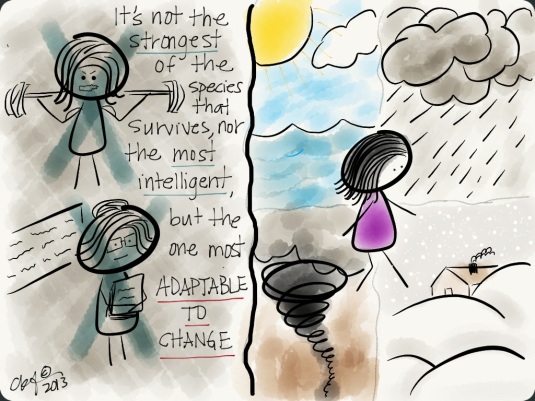
…
It’s not the strongest of the species that survives, nor the most intelligent, but the one most ADAPTABLE to CHANGE.
…
I saw this quote a few days ago and it really hit home. My life is drastically different than it was 10 years ago, even much different than it was five years ago. I will never be able to go back to the life I had so many years ago, and have to keep moving forward, toward adapting to more changes. It’s a necessary acceptance. Some of it is good, while some of it is sad. One thing for certain, though, is that change is constant.
My “normal” keeps changing. I’m sure many of you who visit or follow this blog can relate to how that feels.
Let’s keep forging ahead!
28 Mar 2013
by Fergiemoto
in Uncategorized
Tags: art, creativity, doodles, haiku, health, meditation, nature, photography, photos, poems, poetry, psychology, sketches
>>:::<<
the harder we try
the more evasive the problem
try by not trying
>>:::<<
We all need to take breaks, regardless of what we are doing. I’ve experienced the mental blocks at work where I needed to walk away from a problem and come back to it later with a different perspective. I’ve had the “creativity block” where I just cannot think of a haiku to write, a subject for a blog post, or an image I wanted to work on and what to do with it. Sometimes trying to get rid of anxiety and giving it attention makes the anxiety even worse. With chronic pain, sometimes meditation or a diversion will help temporarily reduce the pain.
There are countless examples where we need breaks. Getting an answer is part of trusting, without being critical, that putting it aside for a while will bring an answer.
I created this image above, which is a combination of a doodle and a photo of a Western Scrub Jay that visits us daily for peanuts. This is my first attempt at what I have been calling a Camera+Doodle. I have more in mind and it is the result of something different I wanted to do. In fact, it was the result of “try by not trying.”
This scrub jay does come very close to us, but I noticed the harder I try to get him to come closer, the more distance he leaves between us. If I just ignore him and go about my business, he usually comes closer. He has yet to take food from my hand, but one of the squirrels here will gently take peanuts from me. Also, a chickadee landed on my hand last fall, picked up a peanut, paused and looked at me for a few seconds before leaving. The closest this scrub jay came to me was recently when I was feeding the squirrel. He landed beside me, looked right at me and squawked as if to say, “Hey! That’s MY peanut!” The squawk made the poor little squirrel jump, and he scampered away.
Some day this scrub jay will take a peanut from me, just like in the image above. I just have to be patient and “try by not trying.”
Do you have examples of “try by not trying” that you would be willing to share? I’d love to know about it!
Linking up with:
WILD BIRD WEDNESDAY
05 Mar 2013
by Fergiemoto
in Uncategorized
Tags: art, chemical sensitivies, creativity, doodles, emotions, fragrance sensitivity, health, invisible illness, MCS, multiple chemical sensitivity, psychology, sketches
In addition to many of the health issues I’ve talked about in this blog, one of the major conditions that has increasingly affected my daily life is my extreme sensitivity to fragrances and certain chemicals. People with sensitivities like me, and others diagnosed with “multiple chemical sensitivity (MCS)” are referred to as “canaries.” We are human canaries. The name “canary” comes from a past practice of miners who would take the birds into the mines with them as an animal sentinel, to provide advanced warning of danger. Canaries are more sensitive to toxic gases than humans, so if the bird stopped singing, got sick, or died, the miners would know they needed to escape the mine or use protective gear before they were affected.
Low levels of fragrances and chemicals that most people probably wouldn’t notice, will make me very sick, so sick that I could be in bed with debilitating migraines, intense sinus pressure and pain, nausea and vomiting for a few days. This includes perfumes and colognes, scented candles, scented lotions, air fresheners, scented laundry products, personal care products, even some flowers, etc. Almost anything that contains fragrance, and some cleaning chemicals, solvents, paints, etc., will affect me.
I don’t know why I am sensitive. I’ve seen doctors and specialists about this. My specialist said that the only thing I can do is to avoid fragrances and chemicals as much as I can. With me, it is an “irritant” and irritants need to be avoided.
I don’t know if there was an initial exposure that started this sensitivity, but I wasn’t always sensitive. It started in my mid-twenties with a few perfumes and gradually escalated over the years to the point where low level exposures or even one whiff of a certain fragrance will make me very ill. Right now, given that the “why” is unknown, the “why” to me is not as important as the fact than “I am” sensitive and need to make significant adjustments in my life and choose my health. Other health issues themselves are already isolating enough, but fragrance and chemical sensitivities make it even worse. This problem affects many decisions I make, and my social life is very limited. Some of the decisions I’m faced with frequently are:
- What products I buy – from household cleaning products to soaps, lotions, makeup, etc. They need to be “fragrance free” or “unscented.”
- What stores, restaurants or other establishments I visit – Will there be air fresheners, scented candles, or too many fragranced people?
- What public events I attend – Is it indoors or outdoors? Outdoors is better with fresh air. In the last few years, I haven’t been able to attend events that I enjoy, like family get-togethers, ballets, musicals, concerts, parties.
- What volunteer or other community service activities I get involved in.
- Who I can be around and who I can socialize with – Will they be wearing fragranced products around me?
- Whose car I ride in.
- Who rides in our cars – Hubby has had to “de-fragrance” our vehicle when people wearing fragrances have ridden with him.
- Whose home I visit – Do they apply perfume, use air fresheners or other scented products?
- Who can enter my home – I have to be strict about who enters where I live. It is the only place where we can make it safe for my condition. Fragrances, especially many scented laundry products these days leave lingering fragrances, especially in upholstery, for several days or weeks. Sometimes I have to leave my home and stay with my mother while hubby “de-fragrances” it.
- What home projects hubby can work on and when – Most likely I will have to leave the house if chemicals are involved.
- When I can go outside –Smells from fragranced laundry products emitted from neighborhood dryer vents trigger a reaction.
- Who my “true” friends are – True and caring friends will help you. They will be considerate, respectful and nonjudgmental of your sensitivities if they value a relationship with you.
Chemical and fragrance sensitivities is a growing problem, and it is concerning to me to learn about the types of ingredients that make up many fragrances these days. I will post more about this later. Over ten years ago when I was searching the Internet for information and resources, I came across only a couple of websites with passing mentions of the problem. Now, when you Google “fragrance sensitivity,” “chemical sensitivity,” “multiple chemical sensitivity” etc., there seems to be endless hits.
For those of us who live with this kind of condition, it is real. It’s not all in our heads. I will post more information in the future. But for now, here’s a question to think about (inspired by blogs from two MCS sufferers, Sherri Connell and Linda Sepp). If a friend or loved one mentions that a certain fragrance or chemical around is making them ill, even if you are the one using a fragranced product, what would you do?
Would you choose the product?
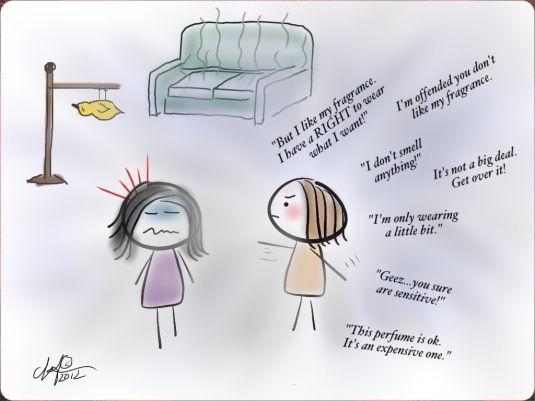
Or
Would you choose the friendship and try to help get your friend away from the problem, or make yourself and your home safe when you are around your friend, regardless of the type of sensitivity they have (food, flowers, environmental, electromagnetic, etc.)?
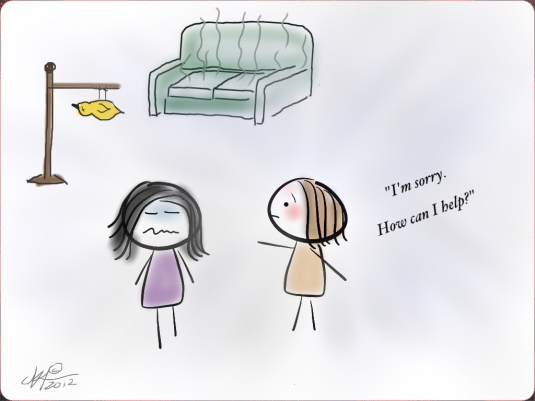
Here are a few fellow bloggers I know of who live with similar sensitivities. If you or someone you know is struggling with chemical or other sensitivities, please feel free to share your experiences in the comments section or let me know if you/they have a blog.
20 Feb 2013
by Fergiemoto
in Uncategorized
Tags: art, creativity, doodles, emotions, encouragement, healing, health, meditation, mind/body, pain, psychology, quotes, sketches
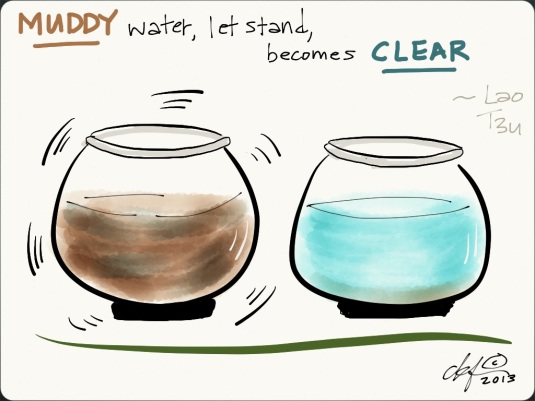
.
Muddy water, let stand, becomes clear. ~ Lao Tzu
Sometimes we just need to take a break to clear our minds or let fresh thoughts and ideas flow in. Here are just a few examples:
- If we are struggling with finding a solution to a problem, it may help to let it rest for a while. Go for a walk or do something else, and return to the problem refreshed rather than continuing to spin our wheels.
- If we are overcome by chronic physical or emotional pain, perhaps a meditative or other relaxing activity will temporarily lessen the intensity.
- If thoughts are racing through our minds, anxiety is elevated, or tempers are flying in a heated interaction, calming down can clear or minimize the turmoil.
- etc.
What are some muddy waters you have faced and what have you done to let it become clear?
08 Feb 2013
by Fergiemoto
in Uncategorized
Tags: art, creativity, doodles, emotions, encouragement, healing, health, mind/body, pain, psychology, quotes, sketches
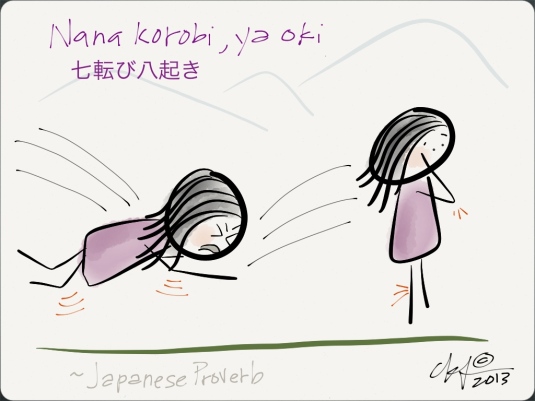
Nana korobi ya oki (七転び八起き) is a Japanese proverb that means, “seven times down, eight times up.”
nana (七) = 7
korobi (転び) = fall down
ya (八) = 8
oki (起き) = get up
It is a saying about perseverance and not giving up no matter how many times you are knocked down. I’ve seen this proverb associated with the Japanese Daruma doll, which is a hollow, round Japanese traditional doll modeled after Bodhidharma, the founder of the Zen sect of Buddhism. These dolls are weighted at the bottom in a way that will always return to an upright position when tilted over.
Never Give Up. May you always get up after a fall.
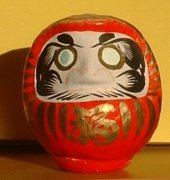
Daruma Doll
Photo courtesy: Wikipedia
31 Oct 2012
by Fergiemoto
in Uncategorized
Tags: acupuncture, alternative medicine, art, chronic pain, craniosacral, creativity, doodles, emotions, haiku, healing, massage therapy, mind/body, psychology, sketches
The guidance in this posting was prepared and provided to me by my Craniosacral Therapist (CST, LMT). She has given me permission to include it in this blog either in verbatim or paraphrased. (FYI – I first posted about my initial experience with CST here.)
My CST has been treating me for many physical issues over the last couple of years including chronic pain in several areas of my body, and recovery from multiple surgeries. Weekly craniosacral and massage therapy sessions from her, regular pain psychology sessions from a licensed psychologist, and periodic acupuncture treatments from a licensed acupuncturist, have provided me with the majority of improvements and answers concerning my recent health issues.
Since the body and the mind are connected, professionals and exercises in both areas are essential for my healing. My CST said it is important to note that she is not a psychologist, and that her work includes how the mind and psyche (such as anxiety, emotions, thoughts, feelings) enter and affect the body physically. Her expertise and treatments have been very helpful for me. The information here is based on her personal experiences and materials she has come across over the years in bodywork trainings, meditation trainings, and teachings she has heard. I thank her for allowing me to include her experiences here. (This image below is a doodle I did to introduce her information.)

.
When you feel a strong emotion arise:
1) Focus on your breath. Connect with the physical sensations of breathing in your body. Do you feel your chest rise and fall, do you feel the breath rush past places in your sinuses or down the back of your throat? Any place you can feel the breath enter and leave, focus there. Your breath is your anchor to the present moment. It’s impossible to breath in the past or future where your mind and/or body often want to go in their remembering or anticipating. To invite yourself fully into the present moment, focus on your breath. Note how your breath feels and what you notice. After noting awareness, invite your breath to gradually become slower, deeper, more relaxed and more regular. I often repeat those four parts to myself when I feel increased anxiety…slower, deeper, more relaxed and more regular. Give yourself several minutes of this practice to slow down. Dr. Andrew Weil teaches this practice as a way to turn off fight or flight response in the body. You may be able to find more information on his website or look for his Breathing: Master Key to Self Healing series.
More
16 Oct 2012
by Fergiemoto
in Uncategorized
Tags: art, chronic pain, creativity, doodles, emotions, encouragement, healing, health, pain, psychology, quotes, sketches

It does not matter how slow you go as long as you don’t stop. ~ Confucius
Many health issues over the last few years, including high chronic pain, have slowed me down significantly. In my healthy heyday, I was constantly on the go and had a good career! Now, I move very slow and am dependent on others to help stabilize me when we leave the house. I feel like I am being left behind in this fast paced world. However, I do have wonderful people closest to me who have stuck with me, supported and encouraged me in many ways, and have slowed their pace to meet mine. This is gold!
Improvements are slow but I am better than I was two years ago. During those times when things get discouraging, it’s important to remember quotes like this. Slow is not bad. It helps one appreciate the things that whizzed by before.
Even if I am moving s l o w l y, it still means there is progress. Remember the story about the tortoise and the hare? In the end, the tortoise won with slow, steady progress.
What are some profound quotes you have handy when experiencing tough times?
24 Jun 2012
by Fergiemoto
in Uncategorized
Tags: art, creativity, emotions, healing, health, mind/body, mindfulness, pain, psychology, quotes
To see things in the seed, that is genius. ~ Lao Tzu
In a previous post I listed some tools to help address emotional pain. One of those tools I learned is creating artwork that represents what you are feeling, such as a drawing, painting, sketching, doodling, photography, etc. It doesn’t have to be fancy and you don’t have to be an artist. The important point to remember is that the energy associated with painful emotions needs an outlet, instead of becoming trapped in the body. Just try to get it out of you. Stopping, distracting, dismissing or suppressing these emotions can surface later in other, potentially harmful ways.
When you create your “emotion” artwork, ask yourself a couple of questions. “What does this picture mean?” “What is it trying to tell me?” It may depict a primary feeling at first, such as sadness, anger, fear, etc. But try to dig deeper and notice other feelings that arise. Don’t be content with the first emotion you are creating because this could help reveal core issues that need to be addressed.
Look at the following doodle for example. Have you ever felt down or discouraged, like you were in a deep hole and didn’t know how to climb out? If this were one of your doodles, what are your initial feelings? Is it hopeless, overwhelmed…? If you dig deeper, what are other feelings that arise? List them…is it sad…lonely…frustrated…angry…isolated…irritated, etc…? The face may not depict all the emotions, but dig deeper. Notice what else you are feeling. More
19 Jan 2012
by Fergiemoto
in Uncategorized
Tags: alternative medicine, art, creativity, emotions, guided imagery, healing, health, meditation, mind/body, psychology
Emotion is the chief source of all becoming-conscious. There can be no transforming of darkness into light and of apathy into movement without emotion. ~ Carl Jung
The key message from my last posting was that emotions, painful ones, need to be represented and processed – they need an outlet. Emotions in general are natural, and they are going to happen. If you try to stop, distract, dismiss,or suppress them, they just find another way to show up. Pain tells us something needs attention.
Since I don’t require medication, and cannot take them anyway, I prefer to use tools to address emotions. Here, I will share some of what I have learned. Many are a repeat or a variation of the tools I listed for addressing physical pain, but I will list them anyway. There are several, but in my opinion, you can never have too many good tools in your toolbox. Some tools are used more than others, some work better than others given the situation, sometimes you need a combination of tools, and others are used infrequently, but it sure is nice to have them when you need them. Everyone needs to find what works best for them with proper guidance from a healthcare provider.
Remember: Distracting an emotion is like taking an aspirin – it just masks the symptoms and doesn’t get at the root. Eventually, the aspirin wears off and the pain returns.
Tools
- Talk to some you can confide in 100% – Talking and expressing your feelings is a key tool, and the most important for me. To be effective, the person you talk to needs to give you their full attention and genuinely want to listen. More
03 Jan 2012
by Fergiemoto
in Alternative Medicine
Tags: acupuncture, alternative medicine, chronic pain, creativity, healing, health, massage therapy, meditation, mind/body, pain, psychology
The best way out is always through. ~ Robert Frost
If you are going through hell, keep going. ~ Winston Churchill
If you are a chronic pain sufferer, you probably have days that are more of a struggle than others. Some even seem impossible to get through, but fortunately, those days are getting fewer and fewer for me.
There are many ways to address physical pain, chronic or not, but with helpful guidance from my healers, here are techniques and exercises I have learned. The exercises are much easier said than done, but practice helps.
- Meditation – This includes “mindfulness meditation.” Meditation helps with relaxing which can help decrease pain.
- Have someone to confide in 100% – Talking it out or leaning on a compassionate shoulder can be very helpful. To be effective, that person needs to give you their full attention and genuinely want to listen.
“We can live without religion and meditation, but we cannot survive without human affection”. ~ Dalai Lama
- Body awareness – As explained to me, “sometimes the way out of pain is to go right through it.”
- Be in the “moment” – Give yourself a break and be in the present. For that time, don’t think about what might happen in the future, or think “what if this never goes away”. Don’t think about how difficult the road to the present has been.
- Gather Moments – Rewind through the activities of a a particularly bad day to find the good things that happened. Write it down and soon you will have a “bouquet of moments” to recall for other challenging days.
- Celebrate the small successes – It’s important to recognize and reward progress.
More
16 Oct 2011
by Fergiemoto
in Uncategorized
Tags: art, creativity, haiku, healing, health, macro, mind/body, mindfulness, nature, photography, photos, poems, poetry, postaweek2011
>>:::<<
Passionate lava
Erupts through delicate veins
Withering cyclone
>>:::<<
This is an attempt to take a photo that represents an emotion that I may be experiencing. I would have a better and quicker variety of art to create if I could draw or paint, but since I don’t have those talents, I look for photo opportunities. The intention is to release the energy caused by that particular emotion and become calmer. Otherwise, the effects of the emotion will continue to build in the body with each occurrence.
As far as the bees, I watched them for a bit, taking several photos. I like this one the best. They continually fought with each other on the flower. It seemed like the bee that was on the flower first was not in the mood to share it with another.
30 Sep 2011
by Fergiemoto
in Photomanipulation
Tags: alternative medicine, art, creativity, haiga, haiku, healing, macro, meditation, mind/body, mindfulness, nature, photography, photos, poems, poetry, postaweek2011, psychology
>>:::<<
Whispers of guidance
Subtle taps at awareness
Enlightened healing!
>>:::<<
The foot feels the foot when it feels the ground ~ Buddha
My previous posting on mindfulness meditation touched on the benefits of becoming more aware of the physical feelings in your body, both large and small. Also, when you pay attention to and study your body, you begin to notice the physical sensations that occur in your body during a particular experience or emotion.
If you ask people what they feel in their body when they experience a certain emotion, a response you might get is, “I don’t know, I’ve never thought about it.” People generally are not aware of these details. More
20 Sep 2011
by Fergiemoto
in Alternative Medicine
Tags: alternative medicine, creativity, guided imagery, healing, health, meditation, mind/body, mindfulness, postaweek2011, psychology
Until you make the unconscious conscious,
it will direct your life and you will call it fate. ~ Carl Jung
Guided imagery and visual imagery are two more techniques based on the concept that the mind and body are connected. They involve the subconscious and imagination and help with stress reduction and relaxation. The subconscious, as explained to me, is like a computer CPU continually processing things in the background, mostly without our knowledge. The conscious is like the computer screen – we only see a portion of what the computer is processing.
In my pain psychology sessions, we approached guided imagery by first selecting something to symbolize my “inner advisor” (the non-conscious, or subconscious self). This could be a person or an animal, etc. – but something that feels safe to be with. The next step was to close my eyes, select a safe and secure place where I can feel relaxed, and visualize this place in my mind. The inner advisor I selected was one of my favorite dogs we had when I was a kid. More
06 Sep 2011
by Fergiemoto
in Photomanipulation
Tags: alternative medicine, art, creativity, haiku, healing, macro, meditation, nature, photography, photos, poems, poetry, postaweek2011, psychology
The creative process is a process of surrender, not control. — Julia Cameron
>>:::<<
Flow with the river
Float with the breeze, bathe in bliss
Notice nothing else
>>:::<<
In my last post, I cited that getting lost in an activity could be considered a type of meditation for me, which allows an escape from some of the pain. I can get lost in certain music, artwork, photographing nature, etc. This is described as Flow psychology (or being present in the moment). It involves being fully immersed and absorbed in an activity to the point you are oblivious to everything else. It is being connected to an activity, to a moment. The expert on this is Mihaly Csikszentmihalyi, a psychologist and educator who emigrated from Europe to the United States in the 1950’s. (I’m unable to pronounce his name correctly.)
The skipper butterfly in the photo above is a good example of Flow, in my opinion. This butterfly was so absorbed in drinking nectar from the flower that it was totally oblivious to me. I stroked its wings, I nudged it back and forth, I put the camera right in its face, which is how I got such a closeup shot, and it did not budge or fly away until it was done. Great Flow! Working on getting this photo and enhancing it afterwards was Flow for me.
What activity is Flow for you?
30 Aug 2011
by Fergiemoto
in Alternative Medicine, Uncategorized
Tags: alternative medicine, conventional medicine, creativity, drugs, healing, meditation, mindfulness, nature, postaweek2011
The soul always knows what to do to heal itself. The challenge is to silence the mind. – Caroline Myss
About a year ago, I began meeting with a pain psychologist hoping I could learn how to manage my pain enough to function reasonably well, and do it without drugs. I didn’t want something that would only cover the symptoms. He told me it would be hard work but I would be learning some valuable tools. I felt relief because it was the first time in a long time I didn’t have drugs pushed towards me. Someone in the healthcare community finally listened to me (I mean really listened), heard me, understood me and supported me. Wow!
At first, I anticipated being coached and refreshed on some deep breathing techniques. Instead, we started with “meditation” – mindfulness meditation. I was surprised because I had never tried meditation before, and I didn’t understand how to do it. I thought, “What does mindfulness really mean?” I pictured myself in nature sitting in the typical meditation fashion, eyes closed and uttering “ommmmm……ommmmm……” More
24 Aug 2011
by Fergiemoto
in Alternative Medicine, Photomanipulation
Tags: art, creativity, haiku, healing, macro, nature, photography, photos, poems, poetry, postaweek2011
>>:::<<
Frayed wings reveal grief
Heart desires pristine respite
Mind soldiers forward
>>:::<<
This butterfly must have quite a story to tell. It seems to have been through a lot, but it’s still pretty. It reminded me of a program I saw recently on monarch butterflies. One of the segments showed a butterfly after a very long migration northward. She had just finished laying her eggs on a milkweed and was trying to fly away. Her wings were tattered and transparent; her colors and design were faded; she was weak and could barely fly. What a journey they have.
22 Aug 2011
by Fergiemoto
in Uncategorized
Tags: art, creativity, healing, photos, poems, poetry
Here is the link to my new creativity blog:
Creativity Aroused – http://creativityaroused.wordpress.com
Ichigo Ichie will still be a place where I share my healing experiences. Creativity Aroused will be a place to post my art – photos, photomanipulations, poems, haiku, etc. I’ll call it my “album of creativity.” It will include the art I post in Ichigo Ichie, and more.
Exploring creativity is part of my healing process, but I wanted a separate place just for my creativity attempts, whatever comes to mind, and for whatever reason.
Please stop by and say hello!
15 Aug 2011
by Fergiemoto
in Photomanipulation
Tags: art, creativity, haiku, healing, photography, photos, poems, poetry
>>:::<<
Whirl, swirl, twirl, vortex
Seasons rise and persevere
Life breathes and endures
>>:::<<
03 Aug 2011
by Fergiemoto
in Uncategorized
Tags: art, creativity, haiku, photography, poems, poetry
I originally had a different topic for today’s posting, but this morning I was oddly driven to write something haiku-inspired. I’m puzzled because I’ve never written a bit of voluntary poetry since I was a kid, at least not that I can remember. So, I decided to explore this new request. I chose one of my photos and let the words form around the image. Short as the poetry may be, here is it’s debut:
>>:::<<
Vibrant sun soft hues
Honey made of gentle dustings;
Earth’s supple song
>>:::<<
29 Jul 2011
by Fergiemoto
in Uncategorized
Tags: art, creativity, healing, health, photography, travel
“After climbing a great hill, one only finds that there are many more hills to climb.” — Nelson Mandela
…my first blog posting on my first blog ever. I guess you can also call this my blogging journey.
I thought I would start out with a photo, which I have titled Soul Searching, to represent my journeys. I took this along the Queens Garden Trail at Bryce Canyon National Park in Utah. I’m not a professional photographer – I like to take pictures. I also like to manipulate photos and see what kind of art I can create with them. Exploring creativity is part of my healing process, so I’ll be posting some of my photos and art as we go along. I hope you enjoy them.















